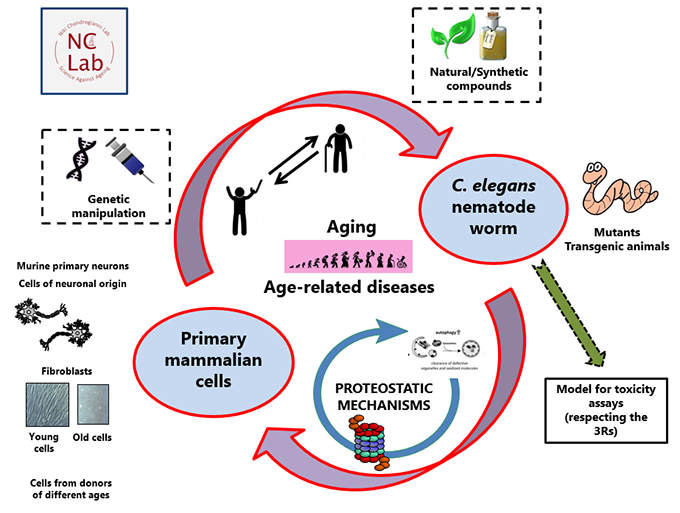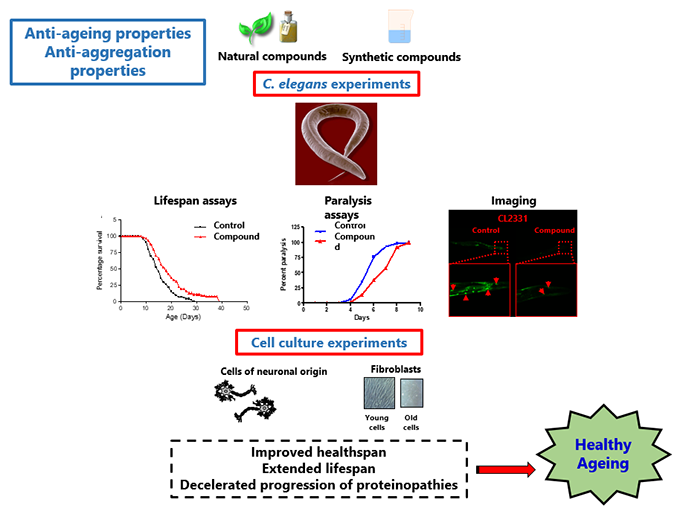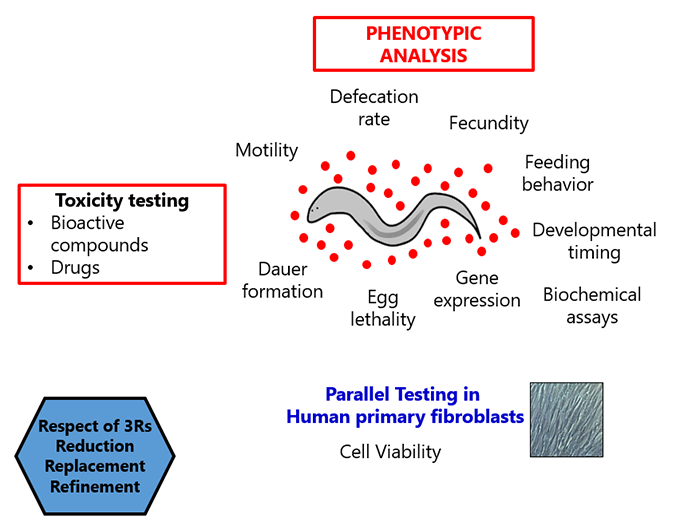
Previous work has revealed that the proteasome expression and function are down-regulated during replicative senescence and human ageing while partial proteasome inhibition results in irreversible premature senescence. We seek to reveal how the expression but also the function of the proteasome is regulated under normal but also stress conditions and upon the progression of replicative senescence, stress-induced premature senescence, ageing and age-related diseases. We investigate the positive or negative effects of various environmental factors (including bioactive compounds found in our normal diet, various kind of stresses etc) on the expression and function of the proteasome. Finally, the proteasome is one of the main actors in the maintenance of protein homeostasis (proteostasis). We aim to reveal how the proteasome cross-talks with other mechanisms of proteostasis (such as autophagy) but also with mechanisms of cellular surveillance that sense and respond to protein damage such as the heat shock response (HSR) or the Unfolded Protein Response in mitochondria (UPRmit).
Related Publications
- Draganidis D., Jamurtas AZ., Chondrogianni N., Mastorakos G., Jung T., Grune T., Papadopoulos C., Papanikolaou K., Papassotiriou I., Papaevgeniou N., Poulios A., Batrakoulis, A., Deli CK., Georgakouli K., Chatzinikolaou A., Karagounis LG., Fatouros I.G. (2021) Low-grade systemic inflammation interferes with anabolic and catabolic characteristics of the aged human skeletal muscle. Oxid. Med.Cell. Longev. 8376915: 1-14.
- Aktypi F., Papaevgeniou N., Voutetakis C., Chatziioannou A., Grune T., Chondrogianni N. (2021) Network analysis in aged C. elegans reveals candidate regulatory genes of ageing. Biogerontology 22: 345-367.
- Binenbaum I., Lefaki M., Chondrogianni N.,* Chatziioannou A. (2020) Bioinformatic framework for analysis of transcription factor changes as the molecular link between replicative cellular senescence signaling pathways and carcinogenesis. Biogerontology 21: 357-366. (* co-corresponding author)
- Sacramento Kelmer E., Kirkpatrick J.M., Mazzetto M., Baumgart M., Bartolome A., Di Sanzo S., Caterino C., Sanguanini M., Papaevgeniou N., Lefaki M., Childs D., Bagnoli S., Terzibasi Tozzini E., Di Fraia D., Romanov N., Sudmant P., Huber W., Chondrogianni N., Vendruscolo M., Cellerino A. and Ori A. (2020) Reduced proteasome activity in the aging brain results in ribosome stoichiometry loss and aggregation. Mol. Syst Biol 16(6):e9596. (cover page)
- Laidou S., Alanis-Lobato G., Pribyl J., Raskó T., Tichy B., Mikulasek K., Tsagiopoulou M., Oppelt J., Kastrinaki G., Lefaki M., Singh M., Zink A., Chondrogianni N., Psomopoulos F., Prigione A., Ivics Z., Pospisilova S., Skladal P., Izsvák Z., Andrade-Navarro M.A., Petrakis S. (2020) Nuclear inclusions of pathogenic ataxin-1 induce oxidative stress and perturb the protein synthesis machinery. Redox Biology 32: 101458
- Papaevgeniou N., Hoehn A., Tur J.A., Klotz L.O., Grune T., Chondrogianni N. (2019) Sugar-derived AGEs accelerate pharyngeal pumping rate and increase the lifespan of Caenorhabditis elegans. Free Radic Res. 13: 1-12
- Sakellari M., Chondrogianni N.*, Gonos E.S. (2019) Protein synthesis inhibition induces proteasome assembly and function. Biochem Biophys Res Commun. 514: 224-230. (* co-corresponding author)
- Athanasopoulou S., Chondrogianni N., Santoro A., Asimaki K., Delitsikou V., Voutetakis K., Fabbri C., Pietruszka B., Kaluza J., Franceschi C., Gonos E.S. (2018) Beneficial effects of elderly tailored Mediterranean diet on the proteasomal proteolysis. Front. Physiol. 9: 457
- Draganidis D., Jamurtas A.Z., Stampoulis T., Laschou V., Deli C.K., Georgakouli K., Papanikolaou K., Chatzinikolaou A., Michalopoulou M., Papadopoulos C., Tsimeas P., Chondrogianni N., Koutedakis Y., Karagounis L.G. and Fatouros I.G. (2018) Disparate habitual physical activity and dietary intake profiles of elderly men with low and elevated systemic inflammation. Nutrients 10 (5), pii: E566
- Kapetanou M., Chondrogianni N.,* Petrakis S., Koliakos G. and Efstathios S. Gonos (2017) Proteasome activation enhances stemness and lifespan of human mesenchymal stem cells. Free Rad. Biol. Med. 103:226-235. (* co-corresponding author)
- Draganidis D., Chondrogianni N., Chatzinikolaou A., Terzis G., Karagounis L.G., Sovatzidis A., Avloniti A., Lefaki M., Protopappa M., Deli C.K., Papanikolaou K., Jamurtas A.Z., Fatouros I.G. (2017) Protein ingestion preserves proteasome activity during intense aseptic inflammation and facilitates skeletal muscle recovery in humans. Br. J. Nutr. 118: 189-200
- Tsolou Α., Nelson G.; Trachana V., Chondrogianni N., Saretzki G., von Zglinicki T.; Gonos E.S. (2012) The 19S proteasome subunit Rpn7 stabilizes DNA damage foci upon genotoxic insult. IUBMB Life 64: 432-442
- Catalgol B., Ziaja I., Breusing N., Jung T., Hoehn A., Alpertunga B., Schroeder P., Chondrogianni N., Gonos E.S., Petropoulos I., Friguet B., Klotz L.O., Krutmann J. and Grune T. (2009) The proteasome is an integral part of solar ultraviolet a radiation-induced gene expression. J. Biol. Chem. 284: 30076-30086
- Chondrogianni N., Trougakos I.P., Kletsas D., Chen Q.M. and Gonos E.S. (2008) Partial proteasome inhibition in human fibroblasts triggers accelerated M1 senescence or M2 crisis depending on p53 and Rb status. Aging Cell,7: 717-732. (journal’s highlight)
- Stratford F.L., Chondrogianni N., Trougakos I.P., Gonos E.S. and Rivett A.J. (2006) Proteasome response to interferon-gamma is altered in senescent human fibroblasts. FEBS Lett. 580: 3989-3994
- Chondrogianni N. and Gonos E.S. (2004) Proteasome inhibition induces a senescence-like phenotype in primary human fibroblasts cultures. Biogerontology 5: 55-61
- Chondrogianni N., Stratford F.L.L., Trougakos I.P., Friguet B., Rivett A.J. and Gonos E.S. (2003) Central role of the proteasome in senescence and survival of human fibroblasts: induction of a senescence-like phenotype upon its inhibition and resistance to stress upon its activation. J. Biol. Chem. 278: 28026–28037
- Chondrogianni N., Petropoulos I., Franceschi C., Friguet B., and Gonos E.S. (2000) Fibroblast cultures from healthy centenarians have an active proteasome. Exp. Gerontol. 35: 721-728







